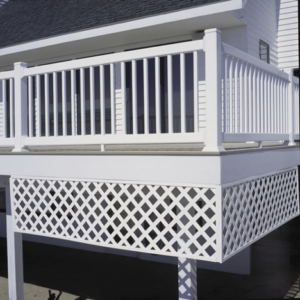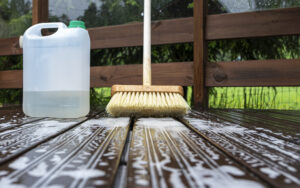Deck Inspection Guide: Ensure Safety and Durability
By Dave Kile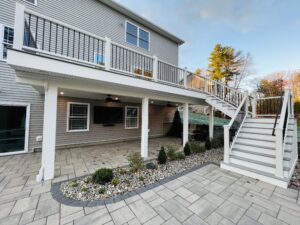
If a DIY inspection isn’t for you, see my tips on hiring a pro to give your deck a safety checkup. Many deck safety concerns are also maintenance issues, and I recommend you inspect your deck annually.
Why Are Deck Inspections Important?
Decks stand in the elements year-round, exposed constantly to rain, snow, ground moisture, heat, cold, and the sun’s damaging UV rays. By inspecting your deck regularly, you can identify problems early and address them before they worsen. This will extend your deck’s service life and ensure it’s safe for you and others to use. A report from the professional home inspectors at InterNACHI provides more details.
Tools Needed for a Deck Inspection
Inspecting a deck can be done with just a flashlight and a flat-blade screwdriver, which is used as a probe for identifying soft wood. Other deck inspection tools to consider include:
- Your cell phone. Use its camera to document your observations. Mount the phone on a selfie stick or use a mirror for difficult-to-reach areas.
- Tape measure. Use it to check joist size and spacing, baluster spacing, railing heights, and joist and beam spans.
- Use this tool to verify that the posts are plumb and the joists aren’t sagging or improperly pitched.
- Moisture meter. This instrument, mostly used during professional deck inspections, detects hidden moisture in wood, which indicates its decay potential.
Inspecting Structural Components
Today’s lumber comes from second-growth trees, and I find it doesn’t provide the hardness or stability that we got from first-growth lumber. That makes a substructure inspection of the beams, joists, posts, and footings even more important. If the problems are severe, you should decide whether to repair or replace your deck.
Beams and Joists
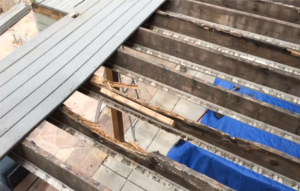
- Moisture. Look for soft, spongy, or crumbling wood, as well as dark spots, streaks, or mold, especially near connections. The nearer the beams or joists are to the ground, the more likely they will show signs of moisture damage or rot.
- Cracks and splits. Look for cracks or splits in the wood that are 1/8″ or larger. A crack could be a sign of overloading, and reinforcement might be needed.
- Sagging and warping. Beams or joists that sag or have warped could be overloaded or undersized. Consider getting a professional evaluation. You might need to install “sister” joists or replace the beam.
- Connections. Assess the number, size, and condition of the nails, screws, bolts, and hardware that connect the structure.
- Ledger board. Often hidden by siding, decking and/or flashing, this structural member connects the deck to the house. If you have access below the deck, make sure the ledger is securely fastened with lag bolts or structural screws (not nails).
Posts and Footings

- Rot and decay. As with the joists and beams, look for soft, spongy, or crumbling wood, as well as discoloration or mold/fungi growth. Wood posts should never directly contact soil or concrete because they can wick ground moisture.
- Stability. Push or pull the posts to see if they move. They should not. Verify that the posts are vertically aligned, plumb, and anchored securely to their footings.
- Connections. There should be no gaps between the beams and the posts, and all fasteners and hardware should be secure and free of corrosion.
- Insects. Look for small holes and fine dust residue from boring insects, such as termites or carpenter ants. Damp wood, such as posts in contact with the soil, is especially attractive to insects.
While discovering decay is disappointing, don’t despair. Instead, investigate how you can repair wood rot and prevent it from recurring by using flashing tape.
Inspecting the Decking Surface
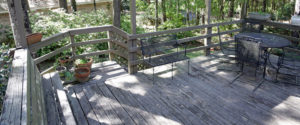
- Cracks, splits, and splinters. These commonly form in pressure-treated wood as it ages. Replace any deck board that shows large cracks, splits or splinters.
- Warping or cupping. If you have deck boards that are lifting, bowing, cupping, or warping, they might be suffering from exposure to excessive moisture or improper installation. And sometimes you just get bad boards. Remove and replace the defective boards.
- Rot and decay. Soft spots and areas stained black or green might indicate a moisture, mold, or rot issue. Check the area where the deck connects to the house and around planters and furniture, which tend to hold moisture against the deck boards.
- Replace any loose, protruding, or corroded fasteners. Make sure no deck boards are loose.
- Spacing between boards. The gaps between deck boards ensure that water drains off, debris passes through, and airflow carries away moisture. The gaps should range from ¼ to 3/8 inch.
- Planters, grills, furniture and leaf litter buildup can all leave a stain. If a mild detergent and scrub brush don’t remove the stain, you can decide to live with it or replace the affected boards. If the dirt, mold, or algae buildup is severe, power washing and/or specialized cleansers might be needed.
Inspecting Railings and Stairs
The building code sets the minimum height for railings and the maximum spacing for its infill (balusters, posts, or panels). Likewise, the code sets upper and lower limits for stairs. For maximum safety, keep these components in top condition.
Railings
- Loose or wobbly railings. Push on the railings and railing posts to check for movement. For railings to be safe, they must be firmly anchored to the posts, and the posts must be anchored to the deck structure. Replace or refasten loose rails and posts.
- Height and spacing. Measure the height of the railing. It should be at least 36 inches (42 inches for elevated decks). Also, measure the gaps between the balusters (spindles) or tensioned cables. No gap should exceed 4 inches.
- Ensure handrails are graspable and meet code for mounting height.
Stairs

- Correct height, depth, and spacing. The stairs should have a uniform depth and riser height and meet the code’s size requirements.
- Check for rot or other defects and be sure the treads are securely attached and level. Treads should be about 10 inches deep and have about a 7.5-inch rise.
- Inspect the stringers (supports for the stairs) for cracks, rot, or signs of overloading. Make sure they’re securely attached to the deck and footings.
- Adding lights at the stairs improves visibility and safety at night.
Check for Signs of Pests and Decay
Identifying infestations or other decay can take diligence because problems often occur in hard-to-see places, such as under deck boards, inside posts, and at the ledger board.
Insect Damage
Boring insects often leave small holes in the wood or a sawdust-like residue. Use a probe to check suspect wood for softness.
Moisture Issues
Water is the enemy of wood, but its effects can be gradual and hard to find. Look for:
Inadequate or missing flashing. The lack of flashing can be difficult to diagnose because the siding or deck boards often cover flashing. You might have to dismantle an area to see what is or isn’t there. Flashing is especially important at the ledger board, so we offer flashing tape designed specifically for ledger boards.
Poor drainage or grading. Ensure that rainfall and other surface water drains away from the deck and doesn’t pool around the posts. If pooling is a problem, slope the site so that water flows away.
Deck Maintenance Tips
Maintenance can be a chore, but it beats making unexpected repairs. To keep your deck in good condition:
- Sweep away debris as needed and wash the deck twice at least twice yearly.
- Watch for protruding fasteners or loose deck boards or fascia and resecure them.
- Shift around furniture, planters and other deck accessories occasionally rapped water and dirt from staining the deck boards.
- Protect wood decks by refinishing them every few years.
- Trim bushes and trees that block sunlight or hamper airflow around the deck.
- Try composite decking materials, which require less maintenance than wood decks.
When to Call a Professional
Hiring a professional deck inspector is a wise choice when structural soundness is in doubt. Here are more reasons to go with a pro:
- Your deck is older than 15 years or gets heavy use.
- There was severe weather—a major storm, hurricane, earthquake, or heavy snowfall.
- You’re planning to buy the house.
- You’re planning to make major modifications, such as adding a hot tub or outdoor kitchen.
- Structural problems or building code compliance concerns.
Choose a professional with experience, the proper certifications, and good reviews. Start with this link to find a builder.
FAQs about Deck Inspection
Inspecting your deck isn’t difficult. It just takes a little time.
How often should I inspect my deck?
Inspect your deck at least once yearly, but more frequently if it’s heavily used, 10 years or older, or exposed to a harsh climate.
How Long Does a Typical Deck Inspection Take?
Inspection times vary according to the deck’s size, age, condition, and complexity. A single-level deck in average condition might take 30 minutes to an hour, and double that for a large or multilevel deck. If the deck has known issues, the inspector could need three hours or more to identify root causes and estimate the scope of repairs.
Are There Specific Seasons or Times of Year Best for Deck Inspections?
No matter the time of year, if you’re buying the house or planning renovations to the deck, have it inspected. Otherwise, spring is a good time to inspect your deck for winter damage and to prepare it for summertime usage.
Sources
Trex. (n.d.). HGTV Smart Home 2024: Before and after transformation story. Retrieved December 10, 2024, from https://www.trex.com/deck-ideas/hgtv-smart-home-2024-before-and-after-transformation-story/
Trex Protect. (n.d.). Deck safety checklist. Retrieved December 10, 2024, from https://trexprotect.com/blog/deck-safety-checklist/
International Association of Certified Home Inspectors. (n.d.). Deck inspections. Retrieved December 10, 2024, from https://www.nachi.org/deck-inspections.htm
Trex Protect. (n.d.). Is it time to repair or replace your deck? Retrieved December 10, 2024, from https://trexprotect.com/blog/is-it-time-to-repair-or-replace-your-deck/
Trex Protect. (n.d.). 5 steps on how to repair wood rot. Retrieved December 10, 2024, from https://trexprotect.com/blog/5-steps-on-how-to-repair-wood-rot/

